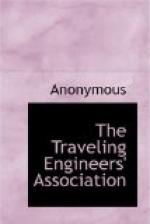A. When any sudden reduction of brake pipe pressure is made below that in the auxiliary reservoir, it will be felt in chamber “h” in front of piston 4 and cause this piston to move to the extreme right, as shown in Fig. 18. This movement of the parts will open port “t” in the slide valve seat and allow air from the auxiliary reservoir to flow to the top of the emergency piston 8, forcing the latter downward and opening emergency valve 10. The unseating of the emergency valve allows the air in chamber “Y” to escape to the brake cylinder, thus permitting brake pipe pressure in chamber “a” to lift the check valve 15 and flow to the brake cylinder through chambers “Y” and “X”, until brake cylinder and brake pipe pressure nearly equalize, when the check valve is forced to its seat by the check valve spring 12, preventing the air in the cylinder from escaping back into the brake pipe again. The emergency valve and piston will now return to their normal position. At the same time port “s” in the slide valve registers with port “r” in the slide valve seat, and allows air from the auxiliary reservoir to flow to the brake cylinder. This sudden discharge of brake pipe air into the brake cylinder has the effect on the next triple valve, which in turn vents brake pipe air that affects the following triple valve and so on throughout the train.
NEW YORK AIR BRAKE
AIR COMPRESSOR
161. Q. What do Figures 19 and 20 represent?
A. These are cross-sectional views of the New York compressor.
162. Q. Of what does the valve gear of this compressor consist?
A. Of two main valves, actuated by tappet rods which enter into the hollow piston rods, and are moved by tappet plates, which are fastened to the steam piston heads.
163. Q. How is the admission and exhaust of steam controlled?
A. The valve under the cylinder at the right controls the flow of steam to and from the cylinder at the left; while the valve under the cylinder at the left controls the flow of steam to and from the cylinder at the right.
164. Q. Explain the operation of the steam end of the compressor.
[Illustration: Low Pressure Piston Moving Upward. High Pressure Piston at Rest. Fig. 19.]
A. Assuming both pistons are at the bottom of their cylinders, when the compressor throttle is opened, live steam will flow to both steam chests “B” (see Fig. 19), and through port “o” to the under side of the piston “T” and through port “g” to the upper side of piston “H”. The steam under piston “T” will force it upward, and when it very nearly completes its stroke, the tappet plate “Q” will engage the button on the end of the tappet rod “P”, moving the main valve “C” to its upper position. In this position the exhaust cavity “r” in the main valve connects port “g” with the exhaust port “X”, thus allowing steam above the piston “H” to escape to the




